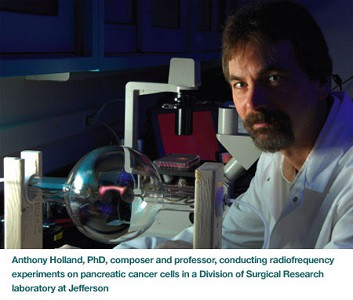
A new cancer treatment uses resonant frequencies to destroy different types of cancer cells.
In his Tedx Talk, "Shattering Cancer with Resonant Frequency", Associate Professor and Music Director at Skidmore College, Anthony Holland, tells the audience that he has a dream. That dream is to see a future where children no longer have to suffer the effects of toxic cancer drugs or radiation therapy, and today he and his team believe they have found the answer.
Many of us have probably seen or heard people break glass with the sound of their voice. This amazing feat, Holland explains, is due to a phenomenon called resonant frequency. When someone knocks on a glass, it gives off a natural resonant frequency. To induce breaking, a person has to match the resonant frequency of the glass with the vibration of their voice and get louder and louder until the glass finally breaks.
Taking this phenomenon into account, Holland and a team of researchers wondered if they could induce the same effect in a living microorganism or cell. They came across the work of Chinese researcher Dr Mae-Wan Ho, who suggested that living cells have similar properties to liquid crystals. With this in mind, Holland and his team wondered if they could influence a cell by sending a specific electrical signal, similar to LCD technology.
After searching the patent database for a device that could achieve the latter, they came across a therapy device invented by a New Mexico doctor named Dr James Bare. The device uses a plasma antenna that switches on and off, which Holland explains is important because a constant pulse of electricity would generate too much heat and thus destroy the cell.
Over the next 15 months, Holland and his team searched for the exact frequency that would directly destroy a living microorganism. The magic number finally came in the form of two inputs, one high frequency and one low. The high frequency had to be exactly eleven times higher than the low frequency, known in music as the 11th harmonic. At this 11th harmonic, microorganisms begin to break like crystal glass.
After researching further until they became efficient at the process, Holland began working with a team of cancer researchers to target and destroy cancer cells. First they looked at pancreatic cancer cells and eventually discovered that these cells were particularly vulnerable between 100,000 - 300,000 Hz.
Next, they moved onto leukaemia cells and were able to destroy the leukaemia cells before they could divide. But, as Holland explains in his talk, he needed bigger statistics to make the treatment a viable option for cancer patients. So what kind of numbers did they produce?
In repeated and controlled experiments, the frequencies known as OPEF (oscillating pulsed electric field) technology killed an average of 25% to 40% of leukaemia cells, and in some cases as much as 60%. What's more, the intervention even slowed cancer cell growth rates by up to 65%. It was a double whammy.
The team also found success in attacking ovarian cancer cells. Most recently, they tested the treatment against the deadly superbug MRSA, an organism that is resistant to many common antibiotics. Thousands of people die from MRSA every year, Holland explains, and the drugs normally used against the pathogen are known to have toxic side effects. Incredibly, frequency therapy eliminated antibiotic resistance, and researchers were able to introduce a small amount of antibiotic to kill the bacteria.
Holland hopes that one day the treatment will override the toxic conventional treatments currently available to patients. At the end of his speech, he describes his vision for the future of cancer clinics:
I believe that the future of children's cancer clinics will be a different place. They will be a place where children meet and make new friends, they probably won't even know they are sick. They will draw pictures, colour in their books and play with their toys, not knowing that above them a beautiful blue plasma light radiates healing, pulsating fields that destroy their cancer painlessly and non-toxically, one cell at a time. Thank you.
It is also worth mentioning that Royal Rife first identified the human cancer virus in 1920 using the most powerful microscope in the world. After identifying and isolating the virus, he decided to grow it on salted pork. At the time, this was a very good method of growing a virus. He then took the culture and injected it into 400 rats, which, as you might expect, very quickly caused cancer in all 400 rats. The next step for Rife is where things took an interesting turn. He later found a frequency of electromagnetic energy that would cause the cancer virus to completely diminish when it entered the energy field. The great discovery led Rife to develop a device that could be tuned to output the frequency that would destroy the cancer. He was then able to treat the cancer in both rats and patients who were in close proximity to the device.
